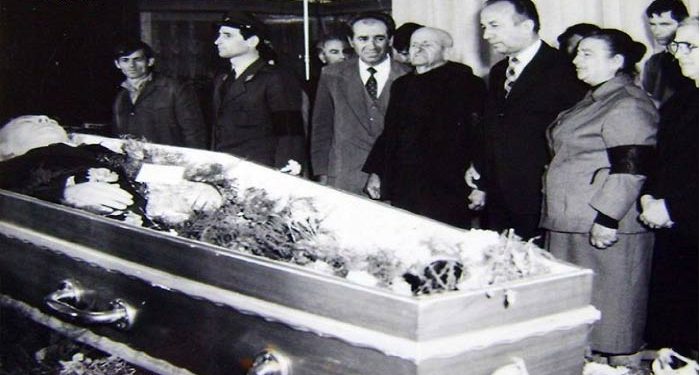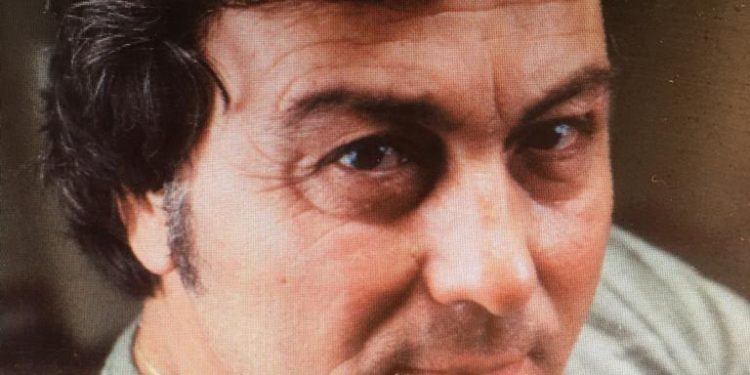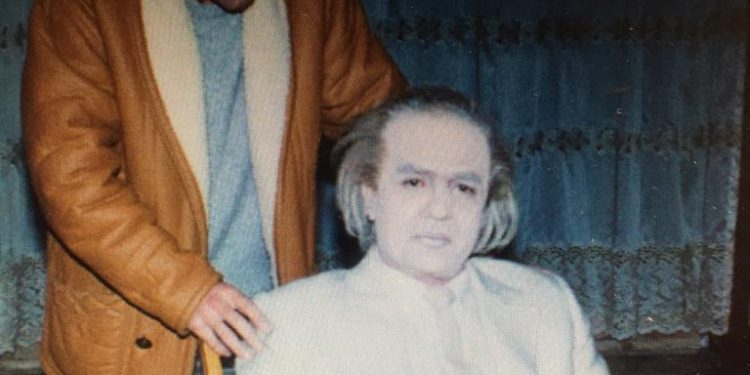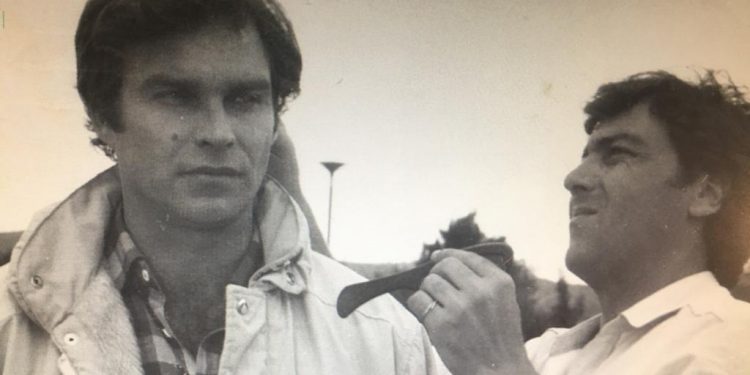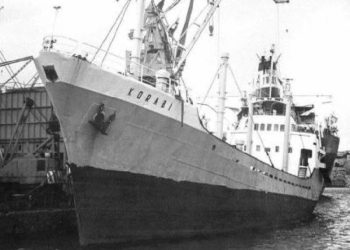Dashnor Kaloçi
Memorie.al publishes the interview of Edmond Lakos, one of the most famous makeup artists of the Albanian Radio-Television, who in April 1985 was urgently called to the Ministry of Internal Affairs where a man of the State Security took him and sent him in the morgue of Tirana where the dead body of Dictator Enver Hoxha was located. What were the messages given by Sulo Gradeci to the make-up artist Lako and two of his colleagues and how did they fix the broken face of the communist leader during all those days when the homage took place…
In the Second Directorate of the Ministry of Internal Affairs we were met by a Security person, who took me in his car and immediately took me to the morgue in Tirana, to the hospital buildings that were surrounded by numerous soldiers of the Republic Guard. As soon as we got off, I also met a colleague of mine, named Walter, who had been picked up by Kinostudio. After that, Sulo Gradeci came and met us, who said: “Why, only you two have come, we need a woman”. After those words, the car that had brought me there immediately left, and after a few minutes she brought Zhaneta Petushi, the other make-up artist of the Albanian Radio-Television. After that, the three of us accompanied us into the morgue, where on one of his tables was the lifeless body of Enver Hoxha, who had been covered with a white sheet and only his head was visible. Inside the morgue were two or three nurses and some State Security civilians communicating by radio with their bosses.
From those who gave us instructions and from Enver’s personal doctor, we learned that a well-known surgeon originally from Shkodra had performed plastic surgery on Enver’s face overnight. He had pulled the skin of the back of the neck in order to eliminate wrinkles on the face and neck. The man who testifies for Memorie.al is the master of make-up, Edmond Lako, one of the most famous make-up painters of the Albanian Radio Television, who tells the rare story that he experienced for a few days in April ’85, when calls for make-up on the lifeless face of Enver Hoxha.
Mr. Mondi, is it true that you dealt with the arrangement and did the make-up on Enver Hoxha’s face, in those days before his funeral ceremony took place and why were you appointed for this?
Yes, it is quite true that I took on that job and she charged me, because at that time I was working as a make-up artist on Albanian Television.
When and how did you hear the news of Enver’s death?
On the morning of April 11, 1985, when the news of Enver Hoxha’s death spread, I was at home and knew nothing about it. At 9.00 the door of the house fell and it was the driver of the general director of the Albanian Radio Television, Kiço Noga, who told me urgently that I should go with him to the Television, where the director Virgjil Kule was waiting for us.
Did the director’s driver tell you the news of Enver’s death?
No, he did not tell me anything, I learned when I went to Television through director Kule.
What did your principal tell you?
Virgil briefly told me about the death of leader Enver Hoxha and then told me that together with the chief of administration, we should immediately go to the warehouse and get the best tools he had there and other necessary equipment used for makeup.
Did the director inform you what those tools were needed for?
Yes, Virgil told me: “Mondi, you will be very careful, because they have decided to fix it”. These were the only words that Director Kule said to me and it was not difficult for me to understand what it was all about.
What do you feel in those moments when your director, Virgjil Kule, communicated to you to go and do the makeup on the face of Enver Hoxha’s lifeless body?
To be honest, I cannot deny the fact that when I was told that, I was shocked. But I had this inwardly in my consciousness, without expressing it from the outside. My steppe, if I may say so, at the moment of learning that news had to do with the fact that, after you dreamed of seeing or meeting one day the leader of your country, suddenly say that he is dead. And worst of all, you are assigned to go and work on his lifeless body.
Why until that time you were never given the opportunity to see Enver Hoxha up close?
I had seen Enver Hoxha twice up close, but I was never given the opportunity to meet him. Both times I had seen Enver up close, I had been filming at the tourist point of Volorek in Pogradec, somewhere near the cadre camp, and Enver Hoxha with the people who accompanied him passed us very close. The second time was in Virua of Gjirokastra. And there he passed us very close, but without meeting us and without greeting us.
After receiving the order from the director of Albanian TV, Virgjil Kule, and the tools, where did you go?
After receiving that order, I, together with the head of the Television administration, went on foot to the Second Directorate of the Ministry of Internal Affairs.
Who did you meet there and where did you go next?
At the Second Directorate of the Ministry of Internal Affairs, we were met by a person who was supposed to be from the Security. Xhemali returned to the Television, while I and the person who was waiting for us, got in his car and immediately went to the morgue in Tirana, to the hospital buildings that were surrounded by numerous soldiers of the Republic Guard, who were armed with weapons.
Who received you there and who did you meet next?
As soon as we got off, I met a colleague, named Walter, who worked at Kinostudio. And he, like me, was called for the same thing. After that, Sulo Gradeci came and met us, who said: “Why only the two of you have come, we need a woman. After that he addressed his people, telling them to go and urgently bring Zhaneta Petushi, with whom he had acquaintance. After a while she came right away.
When you left, were Enver’s body in the morgue?
Enver’s body had been brought to the morgue the day before, when the news of his death had not yet been announced.
Were there other people inside the morgue, where Enver’s body was?
When we went inside, we found two or three nurses and some Security civilians coming in and out communicating with their bosses.
Was Enver’s face damaged and did you immediately start the job for which he was called?
Enver’s face had not suffered any damage, but had changed color. Perhaps this came from the resonance of colors and light-shadows of the environment in which it was located. There in the morgue, we did not take any action, because Sulo Gradeci with the assistant doctor, discussed at length, and said that there in the morgue we did not have optimal conditions for us to work. After the discussions they had with each other, Sulo took our opinion, telling us that it would be better for us to work in the hall of the People’s Assembly. We also supported their opinion, as Sulo told us that during the transport and change of room temperatures, Enver’s face would change, which would harm our work.
What happened next to his body?
After it was decided that we should do the make-up, not there but in the hall of the People’s Assembly, clothes were brought and the nurses together with Zhaneta Petushi started wearing it in a suit.
Where you go, then you said what did happen to the body?
After we went out in the yard of the morgue, Sulo Gradeci, told us to go and wait in readiness in the building of ART, because after two hours they would come again and take us to go to the Assembly hall, where we would start from work for what we were called.
Who did you meet in the Assembly hall, and did they give you any orders?
There Sulo Gradeci received us with Enver’s companion, Behar. They told us to start work immediately and do our best to make Enver’s face look as cured as possible. While we were waiting to start work, Sulo and the people accompanying him started discussing the problem of the refrigerator needed to keep his body intact.
Did they bring the refrigerator there?
Yes, they had brought it in the morning, and with it they had brought some of the best refrigeration specialists in Tirana, because there was a problem that seemed to have not been foreseen. The refrigerator they had brought was shorter than his body. And as he could not push it, Sulo ordered the specialists to find other refrigerated parts to add to it.
Did you have emotions in those moments when you started working on his face, and were you supervised, for the work you were doing?
I started first, to do the make-up, while Walter and Janet helped me because the make-up lasted about two hours. During the time I was working, I had a lot of emotions and I was covered in sweat. Occasionally my hands trembled. During all this time we worked there, Suloja and his men watched over us carefully.
What did they tell you when you finished work?
When we finished the makeup, and were putting the work tools in the bag, Sulo told us we had done a pretty good job. He then instructed us to go home, and to be ready, to appear there at any time that would be required of us. They told us that they had taken our home addresses, and while we were working, the driver had gone to find out the addresses where they were. Before we left, Sulo gave us some instructions, telling us that for everything we had seen, heard, and done there, we would not tell anyone.
What about the next day, when you appeared in the hall of the People’s Assembly?
At 7 o’clock in the morning, the car came and took me home. Together with my two colleagues Valter and Zhaneta, from 8 o’clock we started working again, doing the make-up of Enver Hoxha’s face.
How long did you work that day to do the makeup on his face?
That morning, we did not work hard because we did a slight refresh of the tones we had given to his face, as at night they had faded because the refrigerator had a problem, and during the time we were working, water was constantly flowing. So from this problem of the malfunction of the refrigerator, it was necessary from time to time, to intervene to work on his face.
What was the appreciation for your work did Nexhmija or Sulo congratulate you for what you had done?
We worked until the last moment, that the coffin would be closed, and Sulo thanked us for the work done, bringing us the congratulations of Nexhmija and spring.
When was the mask for Enver Hoxha’s face and hand taken?
The process of taking the mask was done by the great sculptor Montaz Dhrami, when the homage was closed, and it was expected that only the family members would come, for the last time, before the funeral ceremony began./Memorie.al




